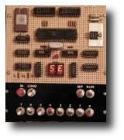General Information
The Cosmac Elf was first published in August 1976 as a DIY kit in the 'Popular Electronics' magazine. It had 256 bytes of RAM, 8 toggle switches for input, 4 hex displays to show the current address and 2 hex displays for data output. Different extensions were published afterwards like a hex keypad and a graphics chip (CDP 1861).
Technical specifications
Clock: 1.76 MHz
Memory:256 Bytes RAM
Video: 2 TIL311 (for two character hexadecimal display)
Sound: None
Keyboard: Toggle switches
Screen shot
Cosmac Elf running Netronics Tiny Basic on a CDP 1861 (Pixie) display.
Links
Other information about the Cosmac Elf:
- August 1976 Popular Electronics magazine
- Cosmac Elf website
- Cosmac Elf on Wikipedia
- Cosmac Elf group

Main Features Cosmac Elf Emulator
- Adjustable speed, boosting the speed of the Cosmac Elf beyond 1.76 MHz!
- Tape features (wav file and real cassette support) including a Turbo version and automatic tape handling for Quest Super BASIC (CLOAD, CSAVE, DLOAD and DSAVE) as well as Tiny BASIC (LOAD and SAVE) commands
- Direct Cosmac Elf memory access to load and save software from the PC hard disk via intel hex, binary, '.super' (for Quest Super Basic) and '.rca' (for RCA Basic) files
- Terminal simulation (DEC VT-52 and VT-100)
- Video support for CDP1861 (Pixie), MC6845, MC6847, TMS 9918 and Intel 8275 all with zoom and full screen option by pressing F3
- Keyboard support for Hex keypad, PS2 and Ascii keyboard
- IDE Hard Disk and FDC support
- RAM extension up to 64KB, EMS Memory expansion (512 KB) or Memory Mapper (1MB)
- Sound support for 'Q flag' connected speaker
- Support for Printer simulation including possibility for sending the output to any printer you own or to a file
- Video screen dump to a file (BMP, JPEG, PNG or PCX image)
- 1805 CPU Mode

